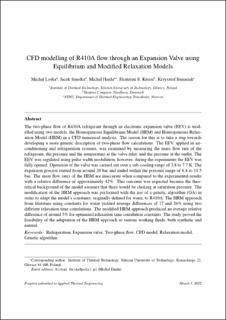| dc.contributor.author | Loska, Michal | |
| dc.contributor.author | Smołka, Jacek | |
| dc.contributor.author | Haida, Michal | |
| dc.contributor.author | Kriezi, Ekaterini E. | |
| dc.contributor.author | Banasiak, Krzysztof | |
| dc.date.accessioned | 2022-09-09T11:07:18Z | |
| dc.date.available | 2022-09-09T11:07:18Z | |
| dc.date.created | 2021-10-25T11:15:13Z | |
| dc.date.issued | 2021 | |
| dc.identifier.citation | Applied Thermal Engineering. 2021, 185 . | en_US |
| dc.identifier.issn | 1359-4311 | |
| dc.identifier.uri | https://hdl.handle.net/11250/3016862 | |
| dc.description.abstract | The two-phase flow of R410A refrigerant through an electronic expansion valve (EEV) is modelled using two models, the Homogeneous Equilibrium Model (HEM) and Homogeneous Relaxation Model (HRM) in a CFD numerical analysis. The reason for this is to take a step towards developing a more generic description of two-phase flow calculations. The EEV, applied in air-conditioning and refrigeration systems, was examined by measuring the mass flow rate of the refrigerant, the pressure and the temperature at the valve inlet, and the pressure at the outlet. The EEV was regulated using pulse width modulation; however, during the experiments the EEV was fully opened. Operation of the valve was carried out over a sub-cooling range of 3.8 to 7.7 K. The expansion process started from around 20 bar and ended within the pressure range of 6.8 to 11.5 bar. The mass flow rates of the HEM are inaccurate when compared to the experimental results with a relative difference of approximately 42%. This outcome was expected because the theoretical background of the model assumes that there would be choking at saturation pressure. The modification of the HRM approach was performed with the use of a genetic algorithm (GA) in order to adapt the model’s constants, originally defined for water, to R410A. The HRM approach from literature using constants for water yielded average differences of 17 and 26% using two different relaxation time correlations. The modified HRM approach produced an average relative difference of around 5% for optimised relaxation time correlation constants. The study proved the feasibility of the adaptation of the HRM approach to various working fluids, both synthetic and natural. | en_US |
| dc.language.iso | eng | en_US |
| dc.publisher | Elsevier | en_US |
| dc.rights | Attribution-NonCommercial-NoDerivatives 4.0 Internasjonal | * |
| dc.rights.uri | http://creativecommons.org/licenses/by-nc-nd/4.0/deed.no | * |
| dc.title | CFD modelling of R410A flow through an expansion valve using equilibrium and modified relaxation models | en_US |
| dc.type | Peer reviewed | en_US |
| dc.type | Journal article | en_US |
| dc.description.version | acceptedVersion | en_US |
| dc.rights.holder | This is the authors' accepted manuscript to an article published by Elsevier. Locked until 23.12.2022 due to copyright restrictions. | en_US |
| dc.source.pagenumber | 17 | en_US |
| dc.source.volume | 185 | en_US |
| dc.source.journal | Applied Thermal Engineering | en_US |
| dc.identifier.doi | 10.1016/j.applthermaleng.2020.116442 | |
| dc.identifier.cristin | 1948181 | |
| cristin.ispublished | true | |
| cristin.fulltext | postprint | |
| cristin.qualitycode | 1 | |

